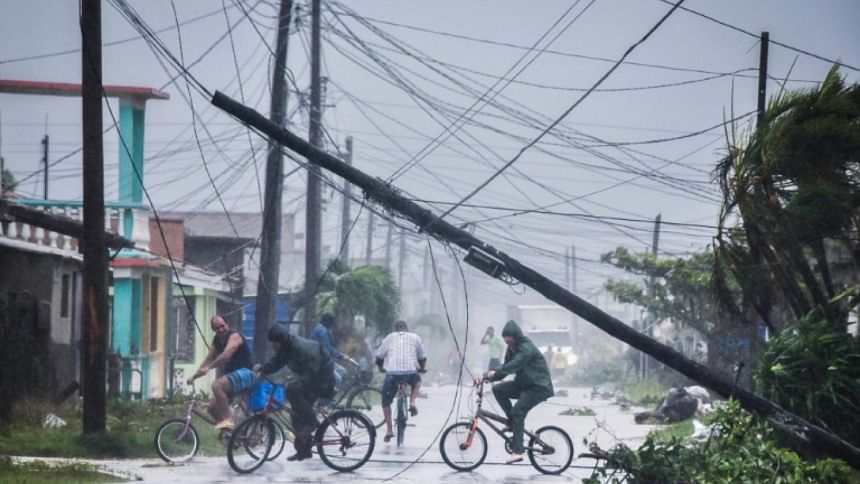Hurricane Irma's fierce winds blast into Florida

Hurricane Irma regained strength Sunday as it began pummeling Florida, lashing its southern island chain with hurricane-force wind gusts and threatening landfall within hours.
Irma, packing winds of 130 miles (210 kilometers) per hour, was upgraded to a Category 4 storm as it closed in on the Florida Keys, the US National Hurricane Center said, as more than six million Floridians -- a third of the state's population -- had been ordered to evacuate their homes ahead of the monster storm.
Hurricane-force gusts began whirling into the Keys as the storm churned about 40 miles (65 kilometers) south-southeast of Key West as of 5:00 am local time (0900 GMT).
"It looks as if the destructive eyewall of Hurricane #Irma will overspread the Lower #FLKeys between 7-8 am" local time, the National Weather Service (NWS) tweeted.
"EVERYONE IN THE FLORIDA KEYS... IT IS TIME TO HUNKER DOWN," the NWS warned.
"THE WORST WINDS ARE YET TO COME."
For those people still at home, it was too late to escape the wrath of what could be the worst hurricane in storm-prone Florida, where nearly 300,000 power outages had already been reported.
In Key West, police had opened a "shelter of last resort" for those who had ignored mandatory evacuation orders.
The cities of Naples, Fort Myers and the densely populated peninsulas of Tampa Bay were in the crosshairs of the massive storm, which threatened storm surges of up to 15 feet (4.5 meters) -- enough to cover a house.
"Life threatening storm surge is occurring now in the Keys and is expected to begin this morning in southwest Florida," warned Florida Governor Rick Scott in an early Sunday tweet.
Take shelter
The NWS urged Floridians to wear suitable footwear and take shelter in lower floor interior rooms -- far from windows -- and use items like helmets, mattresses, pillows and blankets for protection.
At North Collier Regional Park, a designated shelter just outside Naples, anxious evacuees prayed they and their loved ones would remain safe when the storm made landfall.
Viviana Sierra, a Naples resident who was accompanied by her dog, parents and brother, was sanguine about the prospect of eventually going back to find her home and belongings destroyed.
"You can replace material things but your life is very important so I think it's better that we stay here," she said.
The storm was expected to move along or near Florida's southwest Gulf coast later Sunday and into Monday.
But Irma is so wide that authorities were bracing for destructive storm surges on both coasts of Florida and the Keys.
And hurricane-force winds are expected to lash the state as Irma rolls north toward Georgia.
The NHC also warned of tornado risks through Sunday night, with the greatest threat lying in areas east of the storm's path.

Mass exodus
In Florida, cities on both the east and west coasts looked like ghost towns, as nervous residents heeded insistent evacuation orders.
MacDill Air Force Base, the military installation home to US Central Command, issued mandatory evacuation orders with the eye of the storm expected to pass near or over its home city of Tampa early Monday.
The Kennedy Space Center on the east coast was also closed.
Strip malls, fast food restaurants and retail giants were all closed for business.
Scott Abraham, who lives on the fifth floor of a beachfront apartment building in Miami Beach, planned to ignore evacuation orders and ride the storm out with his wife and two kids.
"If I lived in a house I would have left, but if it gets flooded here it's going to take a week at least to come back. I don't want that," he said.
Warning that Irma would be worse than Hurricane Andrew -- which killed 65 people in 1992 -- Florida's governor had said all 20.6 million of the state's inhabitants should prepare to flee.
Cuban-American Orlando Reyes, 82, was forced to leave his assisted living facility in Miami Beach.
"It is frightening," he told AFP at a shelter in Miami. "We had to leave without a cent, without taking a bath, or bringing anything."
'Significant damage'
At least 25 people have been killed since Irma began its devastating march through the Caribbean earlier this week.
Terrified Cubans who rode out Irma in coastal towns -- after the storm made landfall Friday as a maximum-strength Category 5 storm on the Camaguey archipelago -- reported "deafening" winds, uprooted trees and power lines, and blown rooftops.
There were no immediate reports of casualties, but officials reported "significant damage." A total of 1.5 million people were evacuated.
Authorities in Havana organized evacuations from low-lying districts at risk from Atlantic storm surges. Enormous waves lashed the Malecon, the capital's emblematic seafront, causing seawaters to penetrate some 820 feet into the capital, AFP journalists reported.
The storm had smashed through a string of Caribbean islands, beginning with tiny Barbuda on Wednesday, followed by the holiday islands of St Barts and St Martin.
Also affected were the US Virgin Islands, Puerto Rico, the Dominican Republic, Haiti and the Turks and Caicos. The Bahamas were spared the worst of Irma.
Another powerful storm, Hurricane Jose, had been heading toward the same string of Caribbean islands that Irma pummeled in recent days, but the area received a welcome reprieve when the storm began to gradually weaken and shift course towards the north.
The deteriorating weather had grounded aircraft and prevented boats from bringing relief supplies to hard-hit islands.
The US military was mobilising thousands of troops and deploying several large ships to aid with evacuations and humanitarian relief, as the Air Force removed scores of planes from the southern United States.










Comments